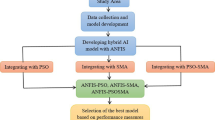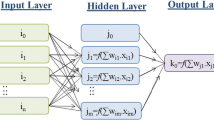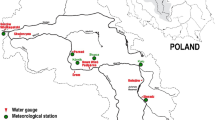Abstract
Modeling suspended sediment load is a critical element of water resources engineering. In this work, using the ANFIS method, everyday suspended sediment particles were estimated in different categories of the river in US Sediment big data, and various flow rates were utilized for testing and training. The artificial intelligent (AI) method called ANFIS is used to train actual data from the river and provide an AI model with artificial data points. This artificial data point can show the occurrence of disaster for a critical day with different flow rates. The changing parameter in the AI model enables us to make a correct decision about critical time for rivers. This study also concentrates on the sensitivity investigation of ANFIS setting parameters on the accurateness of numerical results in order to find the best ANFIS model for rapid oscillation in the data set. The best performance of the ANFIS method is achieved with the trimf membership function, the number of input membership function = 16, and the number of iteration = 1000. The results also showed that the ANFIS model can provide fast computational calculation, and adding more nodes for the prediction cannot change the overall time of calculation due to the meshless behavior of the model. In addition to this model, we used the ant colony method for training of data set, and we found that the ANFIS method is better in learning and prediction of the dataset.










Similar content being viewed by others
Explore related subjects
Discover the latest articles, news and stories from top researchers in related subjects.References
Vanoni V, Sediment discharge formulas. Sedimentation engineering. 1975: the American Society of Civil Engineers. pp 190–229.
Aytek A, Alp M (2008) An application of artificial intelligence for rainfall-runoff modeling. J Earth Syst Sci 117(2):145–155
Karim MF, Kennedy JF (1990) Menu of coupled velocity and sediment-discharge relations for rivers. J Hydraul Eng 116(8):978–996
Lopes VL, Ffolliott PF (1993) Sediment rating curves for a clearcut ponderosa pine watershed in northern Arizona 1. JAWRA J Am Water Resour Assoc 29(3):369–382
Sivakumar S, Diamente PR, van Veggel FC (2006) Silica-coated Ln3+-doped LaF3 nanoparticles as robust down-and upconverting biolabels. Chem—A Eur J 12(22):5878–5884
Pourtousi M et al (2015) Prediction of multiphase flow pattern inside a 3D bubble column reactor using a combination of CFD and ANFIS. RSC Adv 5(104):85652–85672
Varol Y et al (2007) Prediction of flow fields and temperature distributions due to natural convection in a triangular enclosure using adaptive-network-based fuzzy inference system (ANFIS) and artificial neural network (ANN). Int Commun Heat Mass Transf 34(7):887–896
Lei Y et al (2007) Fault diagnosis of rotating machinery based on multiple ANFIS combination with GAs. Mech Syst Signal Process 21(5):2280–2294
Yilmaz I, Kaynar O (2011) Multiple regression, ANN (RBF, MLP) and ANFIS models for prediction of swell potential of clayey soils. Expert Syst Appl 38(5):5958–5966
Panella, M. and A.S. Gallo (2005) An input-output clustering approach to the synthesis of ANFIS networks. IEEE Trans Fuzzy Syst 13(1):69–81
Schurter KC, Roschke PN (2000) Fuzzy modeling of a magnetorheological damper using ANFIS. In: Fuzzy systems, 2000. FUZZ IEEE 2000. The 9th IEEE international conference on. IEEE
Jang J-SR, Sun C-T, Mizutani E (1997) Neuro-fuzzy and soft computing; a computational approach to learning and machine intelligence. IEEE Trans Autom Control 42(10):1482–1484
Boyacioglu MA, Avci D (2010) An adaptive network-based fuzzy inference system (ANFIS) for the prediction of stock market return: the case of the Istanbul stock exchange. Expert Syst Appl 37(12):7908–7912
Avila G, Pacheco-Vega A (2009) Fuzzy-C-means-based classification of thermodynamic-property data: a critical assessment. Numer Heat Transf, Part A: Appl 56(11):880–896
Jang J-S (1993) ANFIS: adaptive-network-based fuzzy inference system. IEEE Trans Syst, Man, Cybern 23(3):665–685
Yun Z et al (2008) RBF neural network and ANFIS-based short-term load forecasting approach in real-time price environment. IEEE Trans Power Syst 23(3):853–858
Varol Y et al (2008) Analysis of adaptive-network-based fuzzy inference system (ANFIS) to estimate buoyancy-induced flow field in partially heated triangular enclosures. Expert Syst Appl 35(4):1989–1997
Ben-Nakhi A, Mahmoud MA, Mahmoud AM (2008) Inter-model comparison of CFD and neural network analysis of natural convection heat transfer in a partitioned enclosure. Appl Math Model 32(9):1834–1847
Xu P et al (2019) Flow visualization and analysis of thermal distribution for the nanofluid by the integration of fuzzy c-means clustering ANFIS structure and CFD methods. J Vis 23(1):1–14
Tian E et al (2019) Simulation of a bubble-column reactor by three-dimensional CFD: multidimension-and function-adaptive network-based fuzzy inference system. Int J Fuzzy Syst 2:411–490
Cao Y et al (2019) Prediction of fluid pattern in a shear flow on intelligent neural nodes using ANFIS and LBM. Neural Comput Appl 32(17):13313–13321
Shamshirband S et al (2020) Prediction of flow characteristics in the bubble column reactor by the artificial pheromone-based communication of biological ants. ArXiv preprint arXiv:2001.04276
Shamshirband S et al (2020) Prediction of flow characteristics in the bubble column reactor by the artificial pheromone-based communication of biological ants. Eng Appl Comput Fluid Mech 14(1):367–378
Babanezhad M et al (2019) Liquid-phase chemical reactors: Development of 3D hybrid model based on CFD-adaptive network-based fuzzy inference system. Can J Chem Eng 97:1676–1684
Nabipour N et al (2020) Prediction of nanofluid temperature inside the cavity by integration of grid partition clustering categorization of a learning structure with the fuzzy system. ACS Omega 5(7):3571–3578
Babanezhad M, Nakhjiri AT, Shirazian S (2020) Changes in the number of membership functions for predicting the gas volume fraction in two-phase flow using grid partition clustering of the ANFIS method. ACS Omega 5(26):16284–16291
Survey, U.S.G. USGS 03403000 Cumberland river near pineville, KY provisional data subject to revision. November 15, 2019. Available from https://waterdata.usgs.gov/nwis/dvreferred_module=sw&site_no=03403000
Cumberland River near Pineville, KY (USGS-03403000) site data in the water quality portal. November 15, 2019. https://www.waterqualitydata.us/provider/NWIS/USGS-KY/USGS-03403000/
Sremac S et al (2018) ANFIS model for determining the economic order quantity. Decis Mak: Appl Manag Eng 1(2):81–92
Stojčić M, Stjepanović A, Stjepanović Đ (2019) ANFIS model for the prediction of generated electricity of photovoltaic modules. Decis Mak: Appl Manag Eng 2(1):35–48
Acknowledgements
This work was supported by the Government of the Russian Federation (Act 211, contract 02.A03.21.0011) and by the Ministry of Science and Higher Education of Russia (grant FENU-2020-0019).
Author information
Authors and Affiliations
Corresponding author
Ethics declarations
Conflict of interest
The author declares that they have no conflict of interest.
Additional information
Publisher's Note
Springer Nature remains neutral with regard to jurisdictional claims in published maps and institutional affiliations.
Rights and permissions
About this article
Cite this article
Babanezhad, M., Behroyan, I., Marjani, A. et al. Artificial intelligence simulation of suspended sediment load with different membership functions of ANFIS. Neural Comput & Applic 33, 6819–6833 (2021). https://doi.org/10.1007/s00521-020-05458-6
Received:
Accepted:
Published:
Issue Date:
DOI: https://doi.org/10.1007/s00521-020-05458-6




